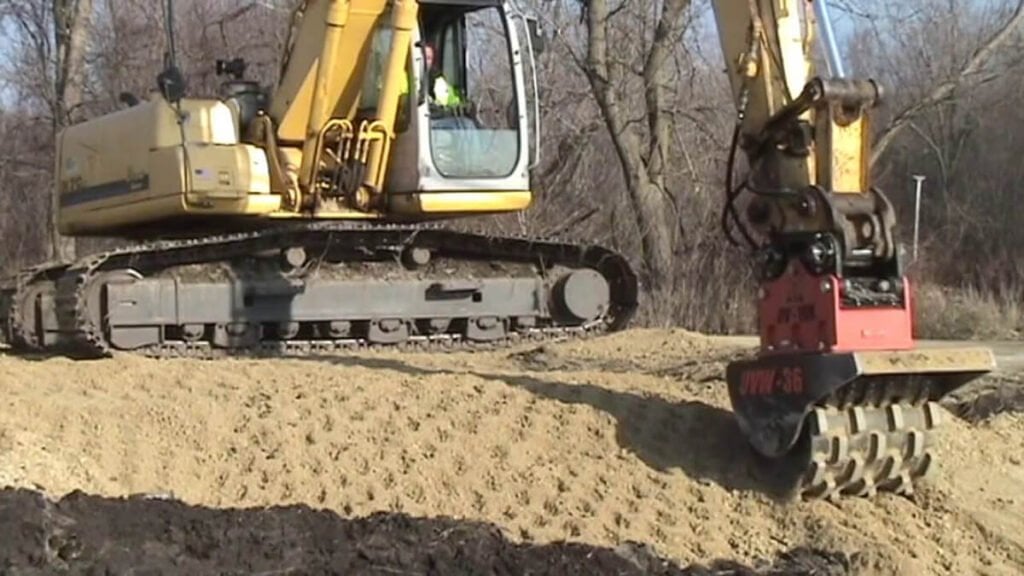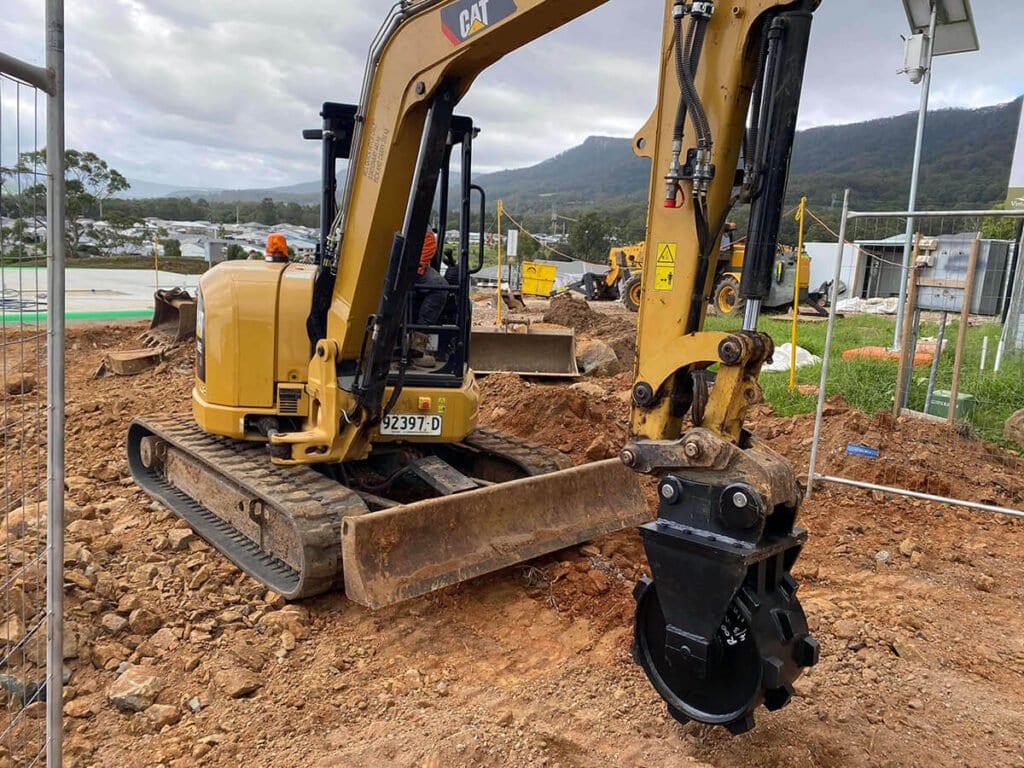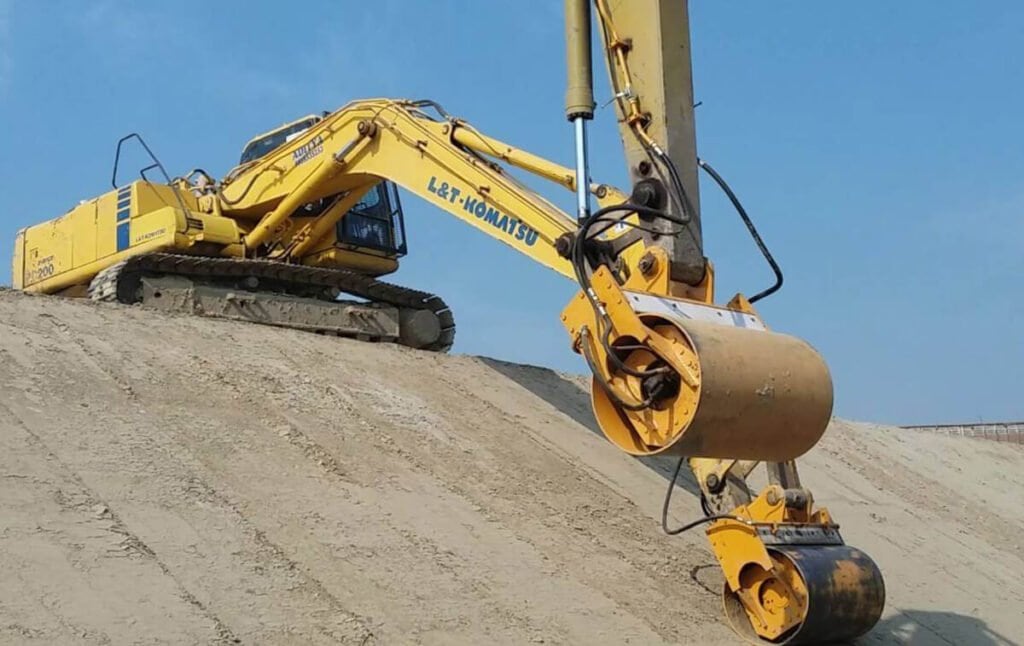Are you struggling with uneven surfaces or suboptimal compaction during your construction or roadwork projects? Whether it’s soil, gravel, or asphalt, achieving the right level of compaction is critical for the durability and stability of your work. Without the proper equipment, manual compaction can be time-consuming, inefficient, and may lead to poor results.
Lack of proper compaction can lead to issues like soil settlement, cracking, and material displacement, which can significantly affect the overall integrity of your project. Moreover, traditional compaction methods can be labor-intensive, slow, and prone to inconsistent results. You need a more effective solution to ensure your surfaces are compacted uniformly and efficiently without wasting time or resources.
An excavator compactor or compaction wheel could be exactly what you need to take your construction project to the next level. These attachments are specifically designed to enhance compaction on various materials, ensuring you achieve a smooth and durable foundation. In this article, we’ll dive deep into what these attachments are, their advantages, and how they can improve the quality and speed of your work.

1. What is an Excavator Compactor?
An excavator compactor is a hydraulic attachment that allows excavators to compact materials like soil, gravel, or asphalt directly from the excavator’s arm. It consists of a large plate or drum that vibrates or applies pressure to the ground to compact it. This attachment helps you achieve a firm, even surface without the need for multiple passes or excessive manual effort.
1.1 Key Components of an Excavator Compactor
- Vibration Plate or Drum: The most essential component of a compactor is its vibration plate or drum. This part vibrates to compress the material beneath it, making the surface firm and stable. Some models feature additional options for adjusting vibration intensity, allowing for customization based on the type of material.
- Hydraulic System: Excavator compactors rely on the excavator’s hydraulic system for power. This connection allows the attachment to deliver the required force for compaction. The efficiency of the hydraulic system directly impacts the compactor’s performance.
- Mounting Bracket: Like other excavator attachments, compactors come with a mounting bracket that secures the unit to the arm of the excavator. These brackets are designed for quick attachment and detachment, making it easy to switch between different tools.
1.2 How the Excavator Compactor Works
The compactor operates by applying pressure and vibration to the surface. The hydraulic system drives the compactor’s plate or drum, allowing it to vibrate or press against the ground. The force exerted compresses the material, pushing air and moisture out, leading to greater density and stability. By adjusting the speed of the excavator and the compaction force, you can achieve the desired level of compaction for different types of materials.

2.Types of Excavator Compactors
Excavator compactors come in different types, each designed for specific tasks and materials. Here are the main types:
2.1 Vibration Plate Compactors
- Function: These compactors feature a large vibrating plate that delivers strong compaction force through vibration. They are effective on granular materials like gravel and sand.
- Best Use: Ideal for use in road construction, foundation work, or areas where soil needs to be compacted in preparation for paving.
2.2 Drum Compactors
- Function: A drum compactor uses a cylindrical drum that rolls over the material, providing pressure without the need for vibration. This is particularly useful when working with less granular materials like clay or asphalt.
- Best Use: Drum compactors are used in areas where a smooth, even surface is needed, such as for asphalt roads, parking lots, or driveways.
2.3 Multi-Tine Compactors
- Function: These compactors feature multiple tines that penetrate the material to deliver compaction by pushing down and mixing the material simultaneously.
- Best Use: Typically used in soft or loose soil applications like trenching or backfilling, providing deeper compaction than other types.

3. Benefits of Using an Excavator Compactor
The use of an excavator compactor offers several advantages over traditional compaction methods. Let’s explore some of the top benefits:
3.1 Faster and More Efficient Compaction
- Higher Productivity: Excavator compactors are designed to compact large areas more efficiently than manual methods or standalone compactors. By attaching the compactor to your excavator, you can cover greater ground in less time, helping you meet tight project deadlines.
- Fewer Equipment Passes: With proper setup and adjustment, you can achieve a well-compacted surface with fewer passes, saving both time and fuel. Traditional compacting methods often require multiple passes to achieve the same result.
3.2 Better Compaction Control
- Adjustable Compaction Force: One of the key advantages of using an excavator compactor is the ability to control compaction force. By adjusting the hydraulic flow, you can tailor the amount of pressure applied, ensuring you get the ideal compaction for different materials and depths.
- Uniform Results: Excavator compactors provide consistent, uniform compaction, minimizing the risk of weak spots or areas of under-compaction that could later lead to issues such as subsidence or cracking.
3.3 Increased Versatility
- Wide Range of Applications: Excavator compactors can be used for various tasks, including road construction, trench compaction, backfill, and asphalt compaction. Their versatility makes them ideal for use in many types of projects, from small landscaping jobs to large-scale infrastructure work.
- Adaptability to Different Materials: Whether you are working with soil, gravel, or asphalt, the excavator compactor is adaptable. The compaction strength and settings can be adjusted to suit the material, ensuring that each layer is compacted to the desired level.
3.4 Reduced Labor Costs
- Minimized Need for Manual Labor: The use of an excavator compactor eliminates the need for labor-intensive manual compaction methods. Workers no longer need to spend hours performing repetitive tasks like tamping or rolling, allowing them to focus on other aspects of the project.
- Lower Equipment Requirements: Since the excavator itself is doing the work, there’s no need to rent or maintain separate compaction equipment, reducing overhead costs. The excavator compactor attachment integrates directly with your existing excavator, simplifying operations and reducing equipment rental expenses.

4. What Is a Compaction Wheel and How Does It Differ from an Excavator Compactor?
A compaction wheel, often used interchangeably with an excavator compactor, is another tool for compacting surfaces, but it functions slightly differently. Instead of relying on a vibrating plate or drum, the compaction wheel uses a set of wheels or rollers to apply force to the surface.
4.1 Key Features of a Compaction Wheel
- Wheel Configuration: A compaction wheel typically consists of multiple rollers or wheels arranged in a circular configuration. These wheels rotate and apply pressure to the material as the excavator moves forward, pushing the material down to achieve compaction.
- Adjustable Settings: Just like the excavator compactor, a compaction wheel can also be adjusted for different surface conditions and material types. Some models feature adjustable roller pressure and speed to allow for fine-tuning during use.
4.2 How a Compaction Wheel Works
The compaction wheel works by using the weight and rotation of its wheels to compress the material beneath it. The wheels are generally fitted with hardened steel rims for durability and to provide maximum pressure when compacting soil or asphalt. These wheels roll over the surface in a smooth and continuous manner, ensuring that the material is compacted evenly.
4.3 Differences Between a Compaction Wheel and Excavator Compactor
- Pressure Mechanism: The compaction wheel applies pressure through rolling, while an excavator compactor typically uses vibration or direct pressure.
- Ideal Applications: A compaction wheel is more suitable for materials that require gradual and smooth compression, such as certain types of soil or asphalt. Excavator compactors, on the other hand, are better for materials that require intense force for compaction.

5. Applications of Excavator Compactors and Compaction Wheels
Both excavator compactors and compaction wheels have a wide range of uses in construction, road maintenance, and other industries. Let’s take a closer look at the different applications:
5.1 Road Construction and Paving
- Base Course Compaction: In road construction, ensuring that the base layer is compacted adequately is crucial for the longevity of the road. Excavator compactors can help achieve the required compaction level for roadbeds before asphalt is laid, ensuring better stability and durability.
- Asphalt Compaction: Both excavator compactors and compaction wheels are used for compacting layers of asphalt to create a smooth and durable road surface. These attachments provide efficient compaction with fewer passes, saving time and labor.
5.2 Trench Compaction
- Trench Backfill: After digging trenches for utility lines, pipes, or cables, it’s essential to compact the backfill material to prevent future settlement. Excavator compactors are perfect for this task, as they can reach into narrow spaces and compact backfill evenly without disrupting surrounding areas.
5.3 Site Preparation
- Gravel and Soil Compaction: For various construction projects, from building foundations to parking lots, achieving the right level of compaction is essential. Excavator compactors and compaction wheels ensure that the ground is solid and level before construction begins, preventing issues like uneven settling or cracking in future structures.

6. Conclusion: Why Choose HIOSEN for Your Excavator Compactor and Compaction Wheel Needs?
At HIOSEN, we offer a wide range of high-quality used excavator compactors and compaction wheels that are perfect for your construction, roadwork, and landscaping needs. With over 15 years of experience in supplying used machinery, we are your trusted partner in finding reliable, efficient equipment at affordable prices. Whether you need to improve compaction on your site or achieve a smooth, stable surface, our excavator attachments will provide the performance you require.
Get in touch with us today to learn more about our products and how they can help you achieve your project goals faster and more efficiently.
